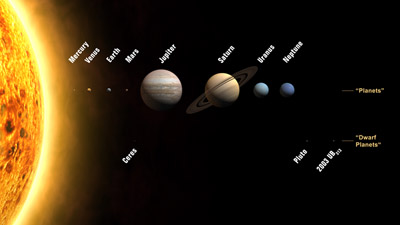|
It's the Astronomy Online non-Blog, or un-Blog.
Everyone has a blog now and since I am no follower of trends, I decided to merge the blog with the website. And I don't want to neglect the website in favor of posting on the blog.
These are the pages that were on the blog of old:
- Home
- Archive (Index of Pages)
- Me
- Current Trends
- Links
- Soho Live
Links:
Google Maps - Mars
Google Maps - Moon
HiRISE
HiRISE - MRO Imaging
Mac Singularity
Meade4M
Slackerpedia Galactica
Software for the Mac
Starry Night Online
Venus Maps
More Favorites:


































Thank you for visiting!
|
|
 |
|
An 8 Planet Solar System - Pluto a Dwarf Planet:
The IAU has voted today (August 24, 2006) that our Solar System has 8 planets. In addition, the IAU has classed Pluto into a new class of planets called "dwarf planets."
Resolution 5A (GA-XXVI):
(1) A “planet” is a celestial body that (a) is in orbit around the Sun, (b) has sufficient mass for its self-gravity to overcome rigid body forces so that it assumes a hydrostatic equilibrium (nearly round) shape, and (c) has cleared the neighbourhood around its orbit.
(2) A “dwarf planet” is a celestial body that (a) is in orbit around the Sun, (b) has sufficient mass for its self-gravity to overcome rigid body forces so that it assumes a hydrostatic equilibrium (nearly round) shape , (c) has not cleared the neighbourhood around its orbit, and (d) is not a satellite.
(3) All other objects except satellites orbiting the Sun shall be referred to collectively as “Small Solar-System Bodies”.
Resolution 6A (GA-XXVI):
Pluto is a “dwarf planet” by the above definition and is recognized as the prototype of a new category of trans-Neptunian objects.
The Solar System now contains the eight "classic" planets: Mercury, Venus, Earth, Mars, Jupiter, Saturn, Uranus and Neptune as well as the new Dwarf Planets - Ceres, Pluto and 2003 UB313.

What is interesting is that Charon (Pluto's moon - visit previous post) was not specifically named in neither of these definitions, nor was the definition of a double-planet indicated. As it stands, it is assumed Charon is still a moon of Pluto.
Any additional large Kuiper Belt Objects or Trans-Neptunian Objects would be classified as dwarf planets if they meet the dwarf planet criteria listed in Resolution 5A.
Image Credit: The International Astronomical Union/Martin Kornmesser
Next Post | Previous Post | Back to Top
|
|

